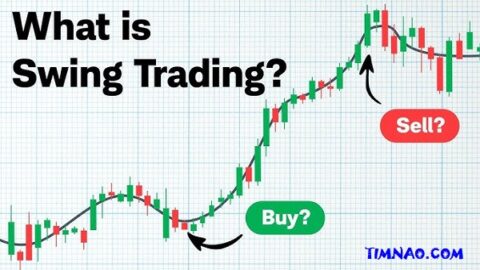🚨 Avoid Costly Mistakes: The Beginner’s Power Guide to Day Trading
Day trading for beginners often feels like stepping into a fast-moving rollercoaster—exciting, unpredictable, and a little intimidating. With headlines of traders making fortunes overnight, it’s easy to believe success is just a few clicks away. But behind every success story, there are countless untold tales of costly mistakes, emotional decisions, and accounts wiped out in hours.
The truth? Day trading is not a magic shortcut to wealth. It’s a high-stakes skill that blends strategy, psychology, and discipline. The good news is, with the right guidance, beginners can avoid common pitfalls and build a smarter, safer path to trading success.
In this guide, we’ll break down day trading in plain English—what it is, how it works, the tools you’ll need, the risks you must respect, and the strategies professionals rely on. Whether you’re looking to supplement your income or simply curious about the markets, this article will equip you with practical, beginner-friendly insights to start your journey with confidence.
Table of Contents
- 📊 What Exactly Is Day Trading?
- 🕒 Why People Choose Day Trading
- ⚖️ The Real Risks Every Beginner Should Know
- 🛠️ Essential Tools and Platforms for Day Traders
- 📈 Popular Day Trading Strategies Explained Simply
- 🧠 Mastering the Psychology of Day Trading
- 💵 Risk and Money Management for Beginners
- ⏱️ How to Start Day Trading Step by Step
- ❌ Common Mistakes New Traders Make (and How to Avoid Them)
- 🌍 Real-World Examples of Successful and Failed Day Trades
- 🔮 The Future of Day Trading: Trends Beginners Should Watch
- ✅ Wrapping It All Together: Your Action Plan
- 🙋 FAQs: Beginner Questions About Day Trading for Beginners Answered
📊 What Exactly Is Day Trading?
At its core, day trading means buying and selling a financial asset—like a stock, a currency pair, or even cryptocurrency—within the same day. Unlike long-term investors who might hold shares for months or years, day traders aim to close all their trades before the market shuts. This way, they avoid overnight risks such as surprise company announcements, government policies, or global events that could cause sudden price swings while they’re asleep.
To understand it more simply, imagine a fruit vendor. Instead of buying apples in bulk and storing them for weeks, hoping they’ll rise in value, the vendor buys them in the morning and sells them by evening, making a small but quick profit. Day traders do something very similar—they ride the price movements within a single day, aiming for multiple small wins rather than one big jackpot.
How Day Trading Works in Practice
Here’s an example: Suppose you notice Apple stock opening at $150 in the morning. Based on recent news and technical patterns, you believe it could rise during the day. You buy 100 shares at $150. A few hours later, the price climbs to $153. You sell and pocket $300 in profit—before lunch. That’s a simple version of a day trade.
Of course, the reverse can happen too. If Apple falls to $147 instead, you’re faced with a $300 loss if you sell. This is why having a plan and risk management strategy is essential in day trading. Without it, it’s easy to let emotions take over, leading to panic-selling or stubbornly holding a losing position.
Day Trading vs. Other Types of Trading
It’s important not to confuse day trading with other styles of market participation:
- Swing Trading: Holding a position for days or weeks, aiming to capture bigger moves.
- Scalping: Ultra-short-term trading where positions last seconds or minutes, aiming for tiny profits multiple times per day.
- Investing: Buying and holding assets long-term, often for years, based on company fundamentals or long-term growth.
Day trading sits in the middle—it’s faster than swing trading but slower than scalping. And unlike long-term investing, it’s more about skill and timing than just letting your money grow over years.
What Markets Can You Day Trade?
Beginners often think day trading only applies to stocks, but the truth is you can day trade almost any liquid market:
- Stocks: Popular for beginners because companies like Tesla, Apple, or Amazon move significantly within a day.
- Forex (foreign exchange): Trading currencies like EUR/USD or USD/JPY. This market is open 24 hours and highly liquid.
- Crypto: Digital currencies like Bitcoin and Ethereum are highly volatile, making them attractive but risky.
- Futures and Commodities: Contracts tied to oil, gold, or agricultural products.
The key is liquidity. A good day trading market has lots of buyers and sellers, which ensures you can enter and exit trades quickly without getting stuck. That’s why seasoned traders often prefer highly traded assets like S&P 500 index funds or top cryptocurrencies.
The Role of Technology
In the past, trading was limited to professionals on Wall Street. They had the advantage of information, connections, and massive capital. But today, anyone with a computer or even a smartphone can day trade. Platforms like TradingView, MetaTrader, and mobile brokerage apps have leveled the playing field.
Still, technology is a double-edged sword. It makes trading accessible, but it also means you’re competing against algorithms and high-frequency traders who can execute thousands of trades per second. That’s why beginners must focus on discipline and strategy, not speed.
🕒 Why People Choose Day Trading
If day trading is so risky, why do so many people try it? The reasons are surprisingly human. Day trading isn’t just about money—it’s about freedom, challenge, and the allure of taking control of your financial destiny. Let’s break it down.
1. The Dream of Financial Freedom
Many people start day trading because they dream of escaping the 9-to-5 grind. The idea of working from anywhere—a café, your living room, or even a beach—feels incredibly attractive. Instead of answering to a boss, you answer only to yourself and the market.
For some, the idea of turning a laptop into a money-making machine feels like the ultimate symbol of independence. And in rare cases, skilled day traders do achieve this lifestyle. But it’s worth remembering: the path there is often filled with months, even years, of trial and error.
2. Low Barriers to Entry
Unlike starting a traditional business, which requires significant upfront investment, day trading only needs three things:
- A brokerage account
- An internet connection
- Starting capital (regulated minimum for stocks in the U.S. is $25,000, but forex and crypto may allow less)
This accessibility is a major reason people jump into trading. With free resources online—like YouTube tutorials, stock screeners, and demo accounts—it feels like anyone can start right away. And technically, they can. But being able to start easily doesn’t mean being able to succeed easily.
3. The Thrill of the Game
Day trading can feel exhilarating. Watching prices move in real time, predicting outcomes, and seeing instant results taps into the same excitement as sports betting or poker. Every trade is a test of your analysis and psychology.
For beginners, this thrill can be both motivating and dangerous. It’s motivating because it keeps you engaged and eager to learn. But it’s dangerous because it can push traders into overtrading—placing too many trades just for the adrenaline rush, rather than sticking to a clear strategy.
4. Potential for High Returns
Let’s be honest—money is the biggest motivator. Traditional investing might grow your wealth slowly, offering around 8% yearly returns on average. That means if you invest $10,000 in an index fund, you might earn $800 in a year.
In contrast, day trading offers the possibility of making that much—or losing it—in a single day. For example, a skilled trader with a $25,000 account might aim to make 1% per day. That’s $250 daily, which adds up to more than $60,000 annually if consistent. Of course, consistency is the challenge. But this potential upside is what lures beginners into trying.
5. Flexibility and Lifestyle
Another appeal of day trading is the lifestyle flexibility. Stock markets typically open at 9:30 a.m. and close at 4:00 p.m. EST. That’s a much shorter workday than most jobs. Some traders only focus on the first two hours of the market open when volatility is highest, freeing up the rest of the day.
Forex and crypto markets, on the other hand, are open nearly 24/7. This allows people in different time zones—or those with unusual schedules—to trade whenever it suits them. For parents, students, or anyone juggling multiple responsibilities, this flexibility can be a huge draw.
6. Intellectual Challenge
Day trading isn’t just about pressing buy or sell—it’s about constant learning. Traders study price charts, news events, economic reports, and psychology. It requires quick thinking, pattern recognition, and decision-making under pressure.
For people who enjoy puzzles or games of strategy, day trading offers endless mental stimulation. The market is always evolving, meaning there’s always something new to learn. For some, that challenge itself is rewarding, even beyond the money.
When you look at why people choose day trading, it’s clear that it combines money, freedom, and challenge in a way few other paths do. But behind the appeal is a reality check: it takes discipline and preparation to turn those dreams into results. Beginners who understand both the excitement and the difficulty are already one step ahead of those chasing quick wins.
⚖️ The Real Risks Every Beginner Should Know
One of the biggest misconceptions about day trading is that it’s an easy way to make quick money. Social media often glorifies traders showing screenshots of massive profits, but what you rarely see are the hidden losses. The truth is, most beginners lose money when they first start day trading—not because it’s impossible, but because they underestimate the risks involved.
Understanding the dangers before you jump in can save you both money and frustration. Let’s break down the main risks beginners must recognize.
Financial Loss Is Almost Guaranteed at First
The hardest pill to swallow for new traders is that losing money is part of the process. Even seasoned traders have losing days or weeks. The key difference is that professionals know how to control their losses, while beginners often let one bad trade snowball into a disaster.
For example, imagine you start with $5,000. You put $1,000 into a single trade, hoping for a quick win. The trade goes against you, and you lose $500 in an hour. That’s 10% of your entire account gone in one move. Without proper risk management, a few mistakes like this can wipe out your account completely.
This is why experts emphasize: never risk money you can’t afford to lose. Think of early losses as tuition—an investment in your education as a trader.
Emotional Rollercoaster
Money is emotional. When your trades go green, you feel like a genius. When they turn red, panic sets in. Beginners often let emotions dictate their decisions, which usually leads to bad outcomes.
- Fear makes you sell too early, missing bigger gains.
- Greed pushes you to hold too long or risk too much.
- Revenge trading makes you jump back into the market after a loss, trying to win it back, usually leading to bigger losses.
The emotional ups and downs can be exhausting. Many traders compare it to riding a rollercoaster every day. Without strong mental discipline, it’s easy to burn out or make reckless decisions.
Time Commitment Is Bigger Than Expected
Day trading is often advertised as a “work a few hours from home and get rich” kind of job. In reality, it requires significant preparation and screen time. Successful traders spend hours studying charts, analyzing news, and refining strategies—often outside market hours.
For example, a U.S. stock trader might spend mornings watching pre-market data, afternoons trading actively, and evenings reviewing their performance. That’s much more time-intensive than most beginners expect. If you’re not ready to commit the time, you may struggle to keep up.
Market Volatility Cuts Both Ways
Volatility—the rapid movement of prices—is what makes day trading possible. Without it, there’s no opportunity to profit from short-term moves. But volatility can also be dangerous. A sudden piece of news or an unexpected event can cause prices to swing wildly in seconds.
Take cryptocurrencies as an example. Bitcoin can move 5–10% in a single day. If you’re on the right side of the move, you win big. If not, you could lose a week’s worth of profits in minutes.
Overconfidence After Early Wins
Ironically, the worst thing that can happen to a beginner is sometimes making money right away. Early success can give you a false sense of skill, leading you to take bigger risks. Many new traders blow up their accounts not after losing streaks, but after a few big wins that made them feel unstoppable.
The market has a way of humbling overconfident traders. That’s why consistency is a better goal than a lucky win.
Hidden Costs Add Up
Even if you manage to make profits, there are costs you need to consider:
- Commissions and fees: Each trade can carry a small cost, which adds up over dozens of trades.
- Spreads: In forex and crypto, brokers earn from the difference between buying and selling prices.
- Taxes: In many countries, short-term trading profits are taxed at higher rates than long-term investments.
These costs can eat into profits, especially for small accounts. Beginners often overlook them until they see their gains shrinking.
🛠️ Essential Tools and Platforms for Day Traders
While risks are real, having the right tools makes day trading more manageable. Think of it like building a house—you wouldn’t try without the right equipment. Beginners don’t need every fancy gadget, but a solid toolkit is non-negotiable.
Here are the essentials.
Brokerage Accounts
Your broker is your gateway to the market. Choosing the right one matters because fees, execution speed, and reliability directly affect your profits.
Popular options include:
- Interactive Brokers: Known for low fees and professional tools.
- TD Ameritrade: Beginner-friendly with strong research features.
- Binance: A go-to platform for crypto traders worldwide.
When choosing a broker, consider:
- Commission fees per trade.
- Platform usability.
- Minimum account size.
- Customer support.
For beginners, a clean and easy-to-use platform often matters more than advanced features.
Trading Platforms
While some brokers have their own platforms, many traders prefer specialized charting software for analysis.
- TradingView: Offers powerful charts and a social community to share ideas.
- MetaTrader 4/5: A classic platform for forex traders with support for automated strategies.
- Thinkorswim (by TD Ameritrade): Great for U.S. stocks with advanced tools.
Good platforms let you customize charts, set alerts, and test strategies. Beginners should practice with demo accounts first to get comfortable.
News and Data Feeds
Day traders live and die by information. A single headline can move prices instantly. Staying informed is part of the job.
Tools to consider:
- Bloomberg and CNBC: Reliable financial news.
- Twitter/X: Real-time updates (but be cautious of rumors).
- Economic calendars: Websites like Forex Factory show key events like interest rate announcements.
Many beginners overlook news feeds, but professionals always keep one eye on the headlines.
Risk Management Tools
No toolkit is complete without risk controls:
- Stop-loss orders: Automatically close a trade if it moves against you.
- Take-profit orders: Lock in gains at a set target.
- Position size calculators: Tools that tell you how much of your account to risk on each trade.
These tools prevent emotions from taking over when things move fast.
Demo Accounts and Simulators
Before risking real money, beginners should practice with demo accounts. These let you trade with virtual money in real market conditions. While it doesn’t replicate the emotional side of trading, it’s invaluable for testing strategies.
Many brokers, including TD Ameritrade and Binance, offer demo modes. Use them to learn order placement, chart reading, and risk management.
Optional But Useful Extras
- Screeners: Tools that scan for stocks or crypto meeting your criteria (e.g., unusual volume or price breakouts).
- Discord/Telegram groups: Communities where traders share ideas (just be careful of hype and scams).
- Journaling apps: Tracking your trades helps you learn from mistakes and refine your style.
Day trading carries undeniable risks, but with the right tools and realistic expectations, beginners can approach the market more safely. It’s not about eliminating risks—they’ll always exist. The goal is to manage them smartly, so losses stay small and survivable while giving yourself a chance to grow.
📈 Popular Day Trading Strategies Explained Simply
If you’ve ever Googled “day trading strategies,” you’ve probably seen dozens of complicated charts and confusing terms. It can feel overwhelming—like you need a PhD in finance just to get started. The truth is, while professional traders often use advanced methods, beginners can focus on a handful of simple strategies that are easier to understand and apply.
Let’s go through the most popular ones, step by step.
1. Momentum Trading
This strategy is like surfing—you’re trying to catch a wave and ride it for as long as possible. Traders look for assets moving strongly in one direction, usually because of breaking news, earnings reports, or unusual trading activity.
Example: Suppose Tesla announces record sales before the market opens. The stock jumps 5% at the opening bell. A momentum trader might buy as soon as volume surges, aiming to ride the wave for another 2–3%. Once the move slows, they sell and lock in profits.
Beginners like momentum trading because it’s straightforward: follow the strong move, but don’t overstay your welcome.
2. Breakout Trading
Breakout trading is about spotting when a stock or crypto pushes through a significant “barrier.” These barriers are usually support (a price it rarely falls below) or resistance (a price it struggles to rise above).
When a price finally breaks through, it often continues in that direction.
Example: Imagine Bitcoin has been bouncing between $28,000 and $30,000 for weeks. If it breaks above $30,000 with high volume, a breakout trader buys in, expecting the rally to continue.
The key is volume. A breakout with low trading volume might be a false signal (called a “fakeout”), so always check that many traders are participating.
3. Scalping
Scalping is the fastest and most intense strategy. Traders make dozens of tiny trades throughout the day, aiming to grab small profits—sometimes just a few cents or pips at a time.
It’s like being a fruit vendor who buys bananas for $1 and sells them for $1.05, but does it 100 times a day. The profit per trade is small, but it adds up.
Scalping requires focus, lightning-fast decision-making, and reliable technology. For beginners, it can be stressful, but practicing on a demo account first can help.
4. Reversal (or Mean Reversion) Trading
Not all traders chase trends—some bet on the trend reversing. Reversal traders look for situations where prices have moved too far, too fast, and are due for a pullback.
Example: A stock usually trades around $50. One morning, bad news sends it crashing to $40 within minutes. A reversal trader might buy, expecting it to “revert to the mean” and bounce back to $45.
This strategy is riskier because prices can keep falling. Beginners should use strict stop-losses to limit losses if the reversal never happens.
5. News-Based Trading
Markets move on information. Earnings reports, government announcements, and even tweets from influential figures can send prices soaring or crashing instantly.
News-based traders keep a close eye on headlines and try to act before the majority catches on. For example, if a biotech company announces FDA approval for a new drug, its stock might skyrocket within minutes. Quick traders can capitalize on the move.
The danger here is overreaction—sometimes the news is already “priced in,” meaning the market expected it, and prices don’t move as much as beginners hope.
How Beginners Should Approach Strategies
It’s tempting to try every strategy at once, but that’s a mistake. The best approach is to pick one strategy that fits your personality and practice it until you understand it well.
- If you like fast-paced action → try scalping.
- If you prefer slower, bigger moves → try breakouts or momentum trading.
- If you enjoy analyzing news → focus on news-based trading.
The goal isn’t to find the “perfect” strategy—it’s to master one approach, stick with it, and improve through practice and journaling.
🧠 Mastering the Psychology of Day Trading
Ask any professional trader what separates winners from losers, and most will give the same answer: psychology. Charts, tools, and strategies are important, but if you can’t control your emotions, you won’t last long in day trading.
Here’s what beginners need to know about trading psychology.
The Battle Between Logic and Emotion
Trading is supposed to be logical—you analyze, plan, and execute. But the reality is, emotions often hijack your decisions. When money is on the line, fear and greed take over.
- Fear: Makes you exit too soon or avoid taking good opportunities.
- Greed: Makes you stay in trades too long, hoping for bigger profits.
- Hope: Keeps you clinging to losing trades, wishing they’ll turn around.
The most successful traders don’t eliminate emotions (that’s impossible)—they learn to manage them.
Common Psychological Pitfalls
- Revenge Trading
After a big loss, beginners often jump into another trade, trying to “win back” the money. This usually ends in even bigger losses. - Overtrading
The excitement of being in the market can make traders take too many positions, even without clear signals. - Paralysis by Analysis
Some beginners freeze, overthinking every decision. By the time they decide, the opportunity is gone. - Confirmation Bias
Traders sometimes only look for information that supports their existing belief, ignoring signs they might be wrong.
Recognizing these traps is the first step to overcoming them.
Building a Strong Trading Mindset
The good news is, you can train your trading psychology just like a muscle. Here are practical tips:
- Create a trading plan: Write down when you’ll enter, when you’ll exit, and how much you’ll risk. Follow it strictly.
- Use stop-losses: Protect yourself from letting one trade ruin your account.
- Journal every trade: Record why you entered, how you felt, and what happened. Over time, you’ll spot patterns in your behavior.
- Set daily limits: Decide in advance how many trades you’ll take or how much you’re willing to lose in a day. Walk away once you hit the limit.
The Importance of Patience
Beginners often want fast results. But in reality, most traders spend months—even years—learning before becoming consistently profitable. Patience is not just about waiting for the right trade, but also about sticking with the learning process through ups and downs.
Think of trading like going to the gym. You won’t see results after one workout. Progress comes slowly, with discipline and consistency.
Building Emotional Resilience
Markets are unpredictable, and losses are part of the game. What matters is how you respond. Resilient traders accept losses as feedback, not failure. Instead of getting discouraged, they adjust and move forward.
One helpful habit is detaching your self-worth from your trading account. Losing money doesn’t mean you’re a failure—it means you made a trade that didn’t work. Tomorrow is a new opportunity.
Day trading strategies can be learned in weeks, but mastering the psychology behind them takes longer. Beginners who pay attention to their mindset from the start give themselves a huge advantage. The market rewards those who stay disciplined, patient, and emotionally balanced—not those who chase quick wins.
💵 Risk and Money Management for Beginners
Ask any professional trader their number one rule, and you’ll often hear the same thing: protect your capital first, aim for profits second. Beginners sometimes think making money is about finding the perfect strategy. In reality, many fail not because their strategies were bad, but because their risk and money management were weak.
Let’s break down the essentials every beginner should know.
Why Risk Management Matters More Than You Think
Imagine you start with $1,000. You take a risky trade and lose 50%. Now your account is down to $500. To recover, you’d need to double your money just to get back to where you started. That’s the math most beginners don’t realize—big losses make recovery much harder.
Good traders don’t aim to win every trade. Instead, they focus on making sure no single loss is big enough to knock them out of the game.
The 1% Rule
One of the simplest and most effective rules is the 1% rule: never risk more than 1% of your trading account on a single trade.
For example, if you have $2,000, your maximum loss per trade should be $20. That way, even if you lose five trades in a row, you’re only down $100 (5% of your account), which is survivable.
This rule keeps beginners from blowing up their accounts after just a few bad trades.
Stop-Loss and Take-Profit Orders
Risk management isn’t just about how much you risk, but how you control trades once they’re open. That’s where stop-loss and take-profit orders come in:
- Stop-loss: Automatically closes a losing trade at a set level to limit your loss.
- Take-profit: Automatically locks in profits when a trade hits your target.
For example, if you buy a stock at $100, you might set a stop-loss at $95 and a take-profit at $110. That way, your maximum loss is $5 per share, and your potential gain is $10.
Beginners often skip stop-losses because they “hope” the market will turn around. But hope is not a strategy—it’s how small losses turn into disasters.
The Risk-to-Reward Ratio
Every trade should have a risk-to-reward ratio that makes sense. If you risk $50, you should aim to make at least $100 (a 1:2 ratio). That way, even if you’re wrong half the time, you can still come out profitable.
Too many beginners do the opposite—they risk $100 to try and make $20. Even if they win often, one or two losses can wipe out weeks of small gains.
Diversify, Even as a Day Trader
While long-term investors diversify across industries and asset classes, day traders can diversify by:
- Trading more than one stock or asset type (stocks + forex, for example).
- Avoiding overexposure to a single sector.
This prevents one bad event—like negative news in tech stocks or a sudden crypto crash—from wiping out your whole account.
Emotional Side of Money Management
Risk management isn’t just about numbers; it’s also about emotions. When you keep risk small, each loss hurts less. That makes it easier to stay calm and stick to your plan. Without limits, emotions take over—and that’s when traders make impulsive mistakes.
⏱️ How to Start Day Trading Step by Step
Now that we’ve covered risks and tools, let’s get practical. If you’re a beginner wondering how to actually get started, here’s a step-by-step guide you can follow.
Step 1: Learn the Basics
Before putting a single dollar on the line, invest in your knowledge. Learn what candlestick charts are, how to read volume, and what terms like “bid,” “ask,” and “spread” mean. Free resources like Investopedia and YouTube trading tutorials are great starting points.
Don’t skip this step—understanding the language of trading is like learning the rules of the game before you play.
Step 2: Choose a Market
Pick one market to focus on. Jumping between stocks, forex, and crypto will only confuse you. Each market has its own rhythm:
- Stocks: Great for learning with plenty of resources available.
- Forex: Runs 24/5, offers high liquidity, but moves in smaller increments.
- Crypto: Available 24/7, very volatile, but can be riskier.
Start with the market that fits your lifestyle and interest.
Step 3: Select a Reliable Broker and Platform
Your broker is your entry point, so choose carefully. Look for one with:
- Low fees and commissions.
- A user-friendly trading platform.
- Good customer support.
If you’re into stocks, platforms like TD Ameritrade or Interactive Brokers are solid. For crypto, Binance and Coinbase are popular.
Step 4: Start With a Demo Account
Before risking real money, practice with a demo account. Treat it seriously—as if it were real money. This is your training ground to learn how orders work, test strategies, and get comfortable without the pressure of losses.
Step 5: Build a Trading Plan
A trading plan is like your personal rulebook. It should answer:
- What strategy will I use? (e.g., momentum, breakout)
- How much will I risk per trade?
- What is my daily loss limit?
- When will I stop trading each day?
Write it down. Following a plan helps you stay disciplined when emotions run high.
Step 6: Fund Your Account Carefully
Only deposit money you can afford to lose. Think of it as “tuition” for your trading education. Start small—many brokers let you begin with as little as $500–$1,000. The goal isn’t to get rich right away; it’s to learn without risking your financial stability.
Step 7: Start Trading Small
Begin with small position sizes. Even if your broker allows you to trade big, keep trades tiny at first. This gives you room to make mistakes without devastating losses.
Example: Instead of buying 100 shares of a stock, start with 10. If you’re wrong, the loss is manageable, and you’ll still learn the lesson.
Step 8: Keep a Trading Journal
Record every trade:
- Why you entered.
- Where you set stop-loss/take-profit.
- How you felt before, during, and after.
- The final outcome.
Over time, this journal becomes a powerful tool to identify patterns in your mistakes and successes. Many traders credit journaling as the turning point in their careers.
Step 9: Focus on Consistency, Not Big Wins
Beginners often want to double their accounts quickly. But professional traders focus on consistency. If you can make small, steady profits over weeks and months, you’re on the right path. Even earning 1% a week consistently is better than chasing 20% in one day and blowing up your account.
Step 10: Keep Learning and Adjusting
Markets evolve. A strategy that works today might not work six months from now. Stay open to learning, update your plan, and adapt as you gain experience.
Joining online communities, reading trading books, and following credible traders can help you keep growing. Just remember to filter out hype and stick to sources that add real value.
Day trading is often marketed as a quick path to riches, but in reality, it’s a long journey of discipline, patience, and self-control. By managing your risk wisely and following a structured step-by-step approach, beginners can greatly improve their chances of surviving—and eventually thriving—in the markets.
The key is not to rush. Trade small, learn daily, and protect your capital. With time, experience, and consistency, day trading can transform from a risky gamble into a real skill set you can grow for years.
❌ Common Mistakes New Traders Make (and How to Avoid Them)
Every beginner walks into day trading with excitement. But the reality is, most new traders stumble over the same handful of mistakes. These slip-ups are costly—but the good news is, once you know what they are, you can avoid them.
Here are the most common traps that catch beginners, and what you can do instead.
Mistake 1: Risking Too Much on One Trade
Many new traders get overconfident. They put a large chunk of their account into a single trade, hoping for a big win. If it goes wrong, they’re wiped out in one move.
How to avoid it: Follow the 1% rule—never risk more than 1% of your account on a single trade. This way, no one mistake can destroy your progress.
Mistake 2: Ignoring Stop-Losses
Beginners often think, “I’ll just watch the trade closely. If it goes against me, I’ll exit manually.” But markets move fast. A sudden drop can wipe out hundreds of dollars before you even react.
How to avoid it: Always use stop-loss orders. Think of them as a seatbelt—you hope you don’t need it, but when things go wrong, it protects you.
Mistake 3: Chasing the Market
Have you ever seen a stock or crypto price shooting up and thought, “I need to get in before it’s too late”? That fear of missing out (FOMO) makes beginners buy at the peak—only to watch prices fall right after.
How to avoid it: Stick to your trading plan. If you missed the setup, let it go. Another opportunity will always come.
Mistake 4: Overtrading
Beginners sometimes feel they need to be in the market all day, every day. They take dozens of trades without clear reasons, often out of boredom or excitement.
How to avoid it: Quality over quantity. Limit yourself to a set number of trades per day. Only trade when your setup appears, not because you “feel like it.”
Mistake 5: Trading Without a Plan
Jumping into trades randomly is like driving without a map. You might get lucky once or twice, but long-term, you’ll get lost.
How to avoid it: Create a simple plan: which strategy you’ll use, your risk per trade, your daily loss limit, and your profit goals. Stick to it no matter what.
Mistake 6: Letting Emotions Take Control
Trading triggers intense emotions—fear, greed, excitement, frustration. Beginners often make decisions based on feelings instead of logic.
How to avoid it: Write down rules before trading and follow them strictly. If you feel emotional, step away from the screen. Remember: discipline beats emotion every time.
Mistake 7: Ignoring the Bigger Picture
Day traders sometimes forget to watch the overall market trend. They focus only on one stock or coin, ignoring what’s happening around it.
How to avoid it: Always check the broader market first. If the entire stock market is falling, betting heavily on a single stock rising may not make sense.
Mistake 8: Failing to Review Trades
Many beginners repeat the same mistakes because they never look back at what went wrong.
How to avoid it: Keep a trading journal. Write down why you entered, what happened, and how you felt. Review it weekly. Over time, you’ll spot patterns that help you improve.
🌍 Real-World Examples of Successful and Failed Day Trades
Theory is great, but nothing sticks like real-world stories. Let’s look at some actual examples of day trades—both good and bad—and the lessons they carry for beginners.
Example 1: The “GameStop” Phenomenon (2021)
In early 2021, GameStop (GME) became the center of one of the most famous trading stories of the decade. Fueled by Reddit communities, the stock skyrocketed from under $20 to nearly $500 in just weeks.
- Successful trade: Some traders who bought early and sold during the rally made life-changing profits. They followed momentum and exited before the crash.
- Failed trade: Many beginners jumped in late, buying at $300 or higher because of FOMO. When the stock fell back under $100, they were stuck with heavy losses.
Lesson for beginners: Don’t chase hype. By the time the news reaches everyone, the best opportunities are usually gone.
Example 2: Tesla Earnings Boost
Tesla often creates opportunities around its earnings announcements. For example, when it reported stronger-than-expected results in 2022, the stock jumped 10% in a single day.
- A prepared day trader who watched the earnings schedule and planned a momentum trade could ride the wave for solid profits.
- A beginner who blindly shorted Tesla because it “looked too high” would have lost quickly.
Lesson for beginners: Trading news works best when you prepare in advance, not when you react at the last minute.
Example 3: Bitcoin’s Sudden Crash (March 2020)
At the start of the COVID-19 pandemic, Bitcoin dropped from around $9,000 to under $5,000 in just two days.
- Smart trader: Someone with stop-losses in place kept losses limited and had cash ready to buy when prices recovered.
- Struggling trader: Many beginners held onto losing positions without protection, hoping Bitcoin would bounce back immediately. Some accounts were completely wiped out.
Lesson for beginners: Always use stop-loss orders, especially in volatile markets like crypto.
Example 4: Apple’s Consistent Opportunities
Unlike dramatic events, some day trading opportunities are steady and reliable. Apple (AAPL), for example, often shows strong volume and predictable moves around product launches or quarterly results.
- Successful traders: Those who patiently wait for these scheduled events and plan breakout or momentum trades can consistently profit.
- Failed traders: Those who guess without research, hoping for random moves, often end up frustrated.
Lesson for beginners: Focus on high-volume, well-known assets where patterns are easier to spot.
Example 5: The Forex Blow-Up
A common story among new forex traders is using too much leverage. For example, a beginner with $500 might use 100:1 leverage, controlling $50,000 worth of currency. Even a tiny 1% move against them could wipe out the account instantly.
Lesson for beginners: Leverage is a double-edged sword. It can amplify profits, but it can just as easily magnify losses. Start small and keep leverage low.
Key Takeaways from Real Trades
- Preparation beats reaction. The traders who succeed plan ahead, not after the move starts.
- Stop-losses are lifesavers. Every failed story could have been smaller if stops were in place.
- Hype is dangerous. By the time everyone is talking about it, the easy money is usually gone.
- Consistency wins. Chasing big wins is exciting, but focusing on small, repeatable trades is what builds lasting success.
Day trading isn’t about hitting one jackpot trade—it’s about surviving, learning, and building discipline. The mistakes of beginners and the examples of real trades all point to the same truth: the market rewards patience, planning, and self-control, not emotion and impulsiveness.
🔮 The Future of Day Trading: Trends Beginners Should Watch
Day trading is always evolving. The strategies that worked five years ago don’t always work today—and what’s coming next could reshape the way beginners approach the markets. If you’re just starting out, paying attention to these trends will help you stay ahead instead of playing catch-up.
1. Artificial Intelligence and Automation
AI isn’t just powering chatbots—it’s changing trading too. Professional traders use algorithms to scan markets in milliseconds, finding opportunities humans might miss. Tools like TradingView already integrate AI signals, and some brokers offer auto-trading bots.
For beginners, this means:
- You’ll have access to smarter tools that can help filter out noise.
- But you’ll need to learn how to interpret signals, not blindly follow them. AI is powerful, but it still makes mistakes.
Think of AI as your co-pilot, not your driver.
2. The Rise of Mobile Trading
Not long ago, traders needed multiple screens and expensive software. Today, platforms like Robinhood, eToro, and Binance offer powerful apps you can use from your phone.
Mobile trading means beginners can learn and practice anywhere, but there’s a risk: impulsive trades. A notification can tempt you to buy or sell without thinking.
The trend is clear—mobile trading will keep growing—but the smart beginners will use it with discipline, not as a gambling machine in their pocket.
3. Social and Copy Trading
Another big shift is social trading. Platforms like eToro let you “copy” the trades of experienced investors automatically.
For beginners, this can be an excellent learning tool—you see how professionals manage risk and time their entries. But there’s a catch: not every “pro” is as skilled as they look. Some take dangerous risks that happen to pay off short term.
If you explore copy trading, treat it as education, not a shortcut to riches. Watch carefully, ask why they made certain trades, and build your own style over time.
4. Crypto and 24/7 Markets
Cryptocurrency isn’t going anywhere. For day traders, crypto offers volatility (big swings in price) and round-the-clock access. Unlike stocks or forex, crypto markets never sleep.
This creates both opportunity and danger. Beginners might feel pressure to stay glued to the screen at all hours. The future will likely bring more automated alerts and tools to help manage trades without constant monitoring.
The takeaway: crypto will remain a huge part of day trading—but treat it with the same discipline as any other market.
5. Regulation and Transparency
Governments worldwide are paying closer attention to day trading, especially in areas like crypto and leverage. Expect stricter rules, more reporting requirements, and possibly limits on risky practices.
For beginners, this is actually good news. Regulation often means safer brokers, more transparency, and better protection against scams. It’s a reminder to always choose platforms that are regulated and trusted.
6. Education is Becoming More Accessible
In the past, trading knowledge was locked away in expensive courses or Wall Street firms. Today, free tutorials, podcasts, and trading communities are everywhere. Even YouTube has detailed lessons on candlestick patterns and strategies.
The future belongs to beginners who take advantage of these resources. With so much knowledge available, the barrier to entry has never been lower—what matters most is filtering quality information from noise.
✅ Wrapping It All Together: Your Action Plan
At this point, you’ve learned what day trading is, the risks, the tools, the strategies, the psychology, and even the mistakes to avoid. But knowing isn’t enough—you need a clear action plan.
Here’s a step-by-step roadmap to guide your next moves:
Step 1: Ground Yourself in Knowledge
Spend at least a few weeks learning the basics before risking money. Focus on:
- How markets work.
- Common strategies (pick just one to start).
- Risk management essentials.
Resources like Investopedia or demo platforms will accelerate your learning.
Step 2: Choose Your Market and Broker
Pick one market to specialize in (stocks, forex, or crypto). Then select a reputable broker that fits your needs. For example:
- Stocks → Interactive Brokers or TD Ameritrade.
- Forex → OANDA or IG.
- Crypto → Binance or Coinbase.
Don’t get distracted by every option. Master one before branching out.
Step 3: Build Your Trading Plan
Your plan should include:
- Strategy: e.g., momentum trading.
- Risk per trade: max 1% of your account.
- Daily stop: a set loss limit that makes you walk away.
- Schedule: when you’ll trade (don’t try to chase markets 24/7).
Write it down. A written plan is a promise to yourself.
Step 4: Practice in a Demo Account
Before using real money, trade in a demo for at least 20–30 sessions. Treat it seriously. Track your trades, learn from mistakes, and only move to real money when you’re consistent.
Step 5: Start Small With Real Money
Begin with the smallest position sizes possible. The goal isn’t to “get rich quick”—it’s to train your brain for the emotional reality of trading real money.
Even if you risk just $10 per trade, you’ll feel the difference compared to a demo account. This emotional training is priceless.
Step 6: Keep a Journal
Record every trade. Over time, you’ll spot patterns: maybe you’re strongest in morning sessions, or weakest after three losing trades in a row. These insights make you better than any course.
Step 7: Stay Disciplined and Keep Learning
Consistency matters more than quick wins. Aim for steady growth, not lottery-ticket trades. Surround yourself with credible sources, but beware of hype communities promising “guaranteed profits.”
Step 8: Adapt to Trends
Keep an eye on the future: AI tools, mobile trading, copy trading, and crypto will shape the market. But remember—no matter the trend, the principles stay the same: manage risk, control emotions, and stick to your plan.
A Final Word of Encouragement
Day trading is not easy. Most beginners lose money because they treat it like gambling instead of a skill. But if you’re willing to learn, stay disciplined, and manage risk wisely, you’re already ahead of the majority.
Think of it this way: the market is like a vast ocean. You can’t control the waves, but you can learn to surf them. Every session teaches you something new. Stay patient, stay humble, and focus on the long game.
Your journey won’t be perfect—but with the right mindset, it can be rewarding, educational, and even profitable.
🙋 FAQs: Beginner Questions About Day Trading for Beginners Answered
If you’re new to day trading, chances are you’ve got a lot of questions. The internet is full of complicated explanations, so let’s cut through the noise and answer the most common beginner questions in plain English.
1. Do I need a lot of money to start day trading?
Not necessarily. You don’t need to be rich to get started, but you do need enough capital to trade safely.
- For U.S. stock markets, the SEC requires at least $25,000 in your account if you want to trade actively (the “pattern day trader rule”).
- For forex and crypto, you can start with a much smaller amount—even a few hundred dollars—but keep in mind that lower capital means smaller profits (and smaller safety cushions).
Pro tip for beginners: Start with a demo account first. Once you’re consistent, begin with small amounts of real money to get used to the emotional side of trading.
2. Can I really make a living from day trading?
Yes, but it’s not as easy as many YouTube ads or online “gurus” make it sound. Most beginners lose money because they treat it like gambling. To make a living, you need:
- Solid risk management.
- A tested strategy.
- Discipline to stick to your plan every day.
Some traders make steady income, but it usually takes years of practice before reaching that level. For most beginners, it’s smarter to view day trading as a side hustle while learning, not your full-time job right away.
3. How long does it take to learn day trading?
Think of day trading like learning a skill—similar to playing guitar or speaking a new language. A few days of study won’t cut it.
- First 1–3 months: Learning the basics (charts, candlesticks, strategies).
- 3–12 months: Practicing in a demo account, making mistakes, refining your plan.
- 1–2 years: Building real consistency with real money.
There’s no shortcut. But the more effort you put in—especially by keeping a journal and reviewing trades—the faster you’ll improve.
4. What’s the best market for beginners: stocks, forex, or crypto?
Each market has pros and cons:
- Stocks: Highly regulated, lots of educational material, but requires higher capital (because of the $25k rule).
- Forex: Runs 24/5, accessible with small accounts, but fast-moving and full of leverage traps.
- Crypto: 24/7 and highly volatile, which means both big opportunities and big risks.
For absolute beginners, many start with stocks because resources are abundant and rules are clear. But if you don’t have a large account, forex or crypto may be more practical.
5. How do I know when to enter and exit a trade?
This is the million-dollar question. The answer depends on your strategy. For example:
- A momentum trader might enter when volume surges and price breaks out above resistance.
- A scalper might enter when short-term charts show tiny repeated patterns.
- A swing/day trader might exit at a pre-defined profit target or stop-loss.
For beginners, the key is to choose one strategy and practice it until you master it. Don’t jump between methods every week.
6. Is day trading gambling?
No, but it can feel like gambling if you trade without a plan.
Gamblers rely on luck. Traders rely on:
- Data (charts, patterns, news).
- Risk management (stop-losses).
- A clear strategy.
When done correctly, day trading is a skill-based activity—closer to chess than roulette. But if you’re trading randomly, it’s gambling.
7. How much time do I need each day for day trading?
It depends on the market and your style:
- Stock traders often focus on the first 1–2 hours after the market opens, when volatility is highest.
- Forex and crypto traders can pick times that fit their schedule, since those markets run nearly 24/7.
Some successful day traders are done by lunchtime. Others prefer a few hours in the evening. Beginners should start with just one consistent session per day, not try to watch markets all the time.
8. What tools or software do I need?
At minimum, you’ll need:
- A broker account to place trades.
- A charting platform (like TradingView) to analyze patterns.
- A stable internet connection.
Optional but useful:
- A trading journal app or even just Excel.
- Educational communities (Discord, Reddit, forums).
- News sources like Bloomberg or CNBC to stay updated.
9. Can beginners use copy trading or trading bots?
Yes, but carefully.
- Copy trading lets you follow professional traders, but not all “pros” are truly skilled. Some take reckless risks.
- Trading bots can automate strategies, but they’re only as good as the rules you set.
If you use them, do so with small amounts first, and treat it as a learning tool. Don’t depend on them to replace your own decision-making.
10. How do I avoid scams in day trading?
Unfortunately, the trading world attracts scammers. Be cautious of:
- Courses or “mentors” promising guaranteed profits.
- Brokers with no regulation.
- Bots or signals advertised as “100% win rate.”
Stick with regulated brokers and always remember: if it sounds too good to be true, it probably is.
11. What’s the biggest mistake beginners make?
The number one mistake: not managing risk.
Many beginners risk too much on one trade, hoping for a big win. When it goes wrong, they blow up their account. Professional traders survive by limiting losses—because in day trading, protecting your capital is more important than chasing every opportunity.
12. Can I start day trading while working a full-time job?
Yes, but you’ll need discipline. If you’re working 9–5, consider:
- Trading forex or crypto, since they’re available outside U.S. stock hours.
- Practicing on weekends with reviews and journals.
- Starting with swing trading (holding trades for days) before moving into shorter intraday trades.
Many traders begin this way—balancing work and trading until they’re confident enough to scale up.
13. Is day trading suitable for everyone?
No. Day trading requires:
- Patience.
- Discipline.
- Willingness to lose without giving up.
If you hate stress, can’t stand screen time, or dislike numbers, day trading might not be your path. And that’s okay—long-term investing or other income streams may suit you better.
14. What should be my first step today?
The best first step: open a demo account and start practicing. Learn how orders work, how charts move, and how your emotions react when prices change. Once you’re comfortable, slowly move into small real trades.
Think of it like learning to drive: you wouldn’t start on a highway at full speed—you’d practice in an empty lot first.
What This Means for Beginners
As a beginner, your questions are normal—and asking them puts you ahead of those who rush in without thinking. The truth is, day trading is not about quick riches. It’s about building a skill that rewards discipline, learning, and consistency.
If you stay curious, practice regularly, and protect your capital, you’ll avoid most beginner pitfalls and set yourself up for steady progress.
⚠️ Disclaimers
- Not Financial Advice
The information in this article is provided for educational and informational purposes only. It should not be interpreted as financial advice, investment recommendations, or an endorsement of any particular trading strategy, broker, or platform. - Risk of Loss
Day trading involves significant financial risk. Prices in stock, forex, and cryptocurrency markets can be highly volatile, and it is possible to lose some or all of your invested capital. You should never trade with money you cannot afford to lose. - Do Your Own Research
Readers are strongly encouraged to conduct their own research or consult with a licensed financial advisor before making any trading or investment decisions. Past performance of strategies, markets, or individual traders does not guarantee future results. - No Guarantees
While this article discusses tools, strategies, and real-world examples, there are no guarantees of profit. Trading success requires practice, discipline, and a deep understanding of the markets. - Third-Party References
Any mentions of brokers, platforms, or tools (such as TradingView, Binance, or Interactive Brokers) are for informational purposes only. We do not endorse or receive compensation for mentioning them unless explicitly stated.










